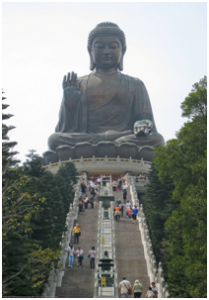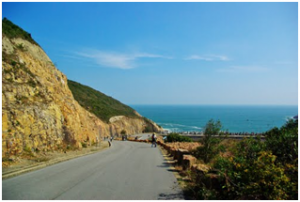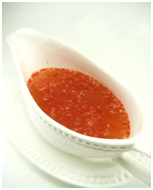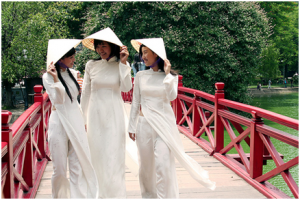Do you Know Mike Sui?
There are many interesting stories happened in your journey of Mandarin learning.
Recently, Mike Sui is very popular among Chinese learners. Have a look at his performance at the bar.
He imitated different accents in this short video:
Hope you enjoy your learning with Our SLS excellent teachers!
Historical and Cultural Destinations in Hong Kong
As one of the four Asian Dragons, Hong Kong is notable as a city of modernization and pompousness where leads as the centre of international financial transaction, shopping heaven and the birth place of many world-wide well-known actors such as Bruce Lee, Jackie Chan and Chow-Yun Fa. Today, I want to take you on a quick tour to three historical and cultural destinations in Hong Kong which you should not miss if you plan to visit Hong Kong soon:
1. The Tian Tan Buddha (天壇大佛)
Located on the largest island of Hong Kong – Lantau Island, The Tan Tian Buddha, which is known as one of the five biggest Buddha statues in China, is a must- see attraction. The Buddha is a-250-metric ton-bronze statue with the height of 112-foot sitting solemnly on a lotus throne. Completed in 1993, this statue is constructed upon a three-platform altar and visitors have to climb 268 steps to reach it. This Tian Tan Buddha statue represents the connection between people’s beliefs and religion, human and the universe
2. Hong Kong Global Geopark of China (中國香港世界地質公園)
Situated in the East and Northeast New Territories, the area of the Hong Kong Global Geopark of China equals to 5000 hectares. It features 8 areas which form across the Sai Kung Volcanic Rock Region and the Northeast New Territory Sedimentary Rock Region. In 2011, the Geopark was admitted as a member of the Global Geoparks Network by UNESCO.
3. Tin Hau Temple in Joss House Bay (大廟灣天后廟)
Built in 1266, Tin Hau Temple in Joss House Bay is famous as the largest and oldest Tin Hau Temple in Hong Kong, also known as the Big Temple (大廟). On the Tin Hau’s birthday (on 23rd of March of Lunar calendar), many devotee and visitors come to pray for their safety and success. Unfortunately, after being repaired for several times in 1840, 1877 and 1962, the temple has lost its original shape.
Vietnamese Dipping Fish Sauce
As how popular wasabi is to Japanese, ketchup is to French and plum sauce to Chinese, when people mention Vietnamese dishes, fish sauce is the top one bear in their minds. It has an indispensable role for much Vietnamese cuisine since it can be use as an ingredient for cooking or an element to make dipping sauce.
Vietnamese dipping fish sauce is a mixture made from fish sauce, lime juice, minced garlic, chilies, sugar and water (or coconut juice). As fish sauce is salty, lime juice is sour, garlic and chilies are spicy and coconut juice and sugar are sweet, this dipping sauce symbolizes for a life which has bitterness, pungency, gladness and happiness. While we cannot predict what taste of our lives is, the taste of this sauce is various depending on personal preference.
The taste of the dipping fish sauce is different by each region. While Northern Vietnamese people prefer adding broth cooked by pork and penaeid shrimp, people in the central part is in favor with the salty taste by adding less water. Moreover, people from the South choose coconut juice instead of water.
Next, I will show you how to make Vietnamese dipping fish sauce: firstly, dissolve the sugar and water is the prior step. Next, add lime juice or vinegar to the mixture and followed are minced garlic and chilies. Finally, fish sauce is poured into the mixture to complete a delicious and healthy dipping sauce.
Now, you have your own Vietnamese dipping fish sauce! Well done!!!
Áo dài and nón lá
(aodai and palm-leaf conical hat)
Whoever has visited Vietnam would be impressed by the image of girls dressed in aodai. Conventionally, the aodai is separated into two parts: the fitting dress with high collar which is long and loosen the body; the pair of trousers which is ankle-length. The price to possess an aodai is different from its fabrics and the including accessories. Tailors prefer the fabrics which do not easy to crush like silk and synthetic to ensure the comfortableness for people who wear them. The original version of aodai was stitched up in 1744 when everyone was decreed to dress an ensemble by the king Vu Vuong of the Nguyen Dynasty. While áo dài is the monopoly garment for woman, áo gấm is the one for men.
Similarly, nón lá (palm-leaf conical hat) which is stitched from palm leaves and Moc’s or bamboo’s bark also symbolizes for Vietnamese custom. It represents the hard-working but pleasant life of people from paddy field to fishing field. Tourists can experience the process of making nón lá in Chuong village which locates 30km south west of Ha Noi. Nón lá is used to protect farmers from the fierce sunshine or as a souvenir for foreigners to memorize the time they spend in Vietnam.
The image of Vietnamese lady wearing nón lá and áo dài is a symbol of beauty which tourists will never forget.
Some Stories About Our Japanese Course 10
Hi everyone,皆さん、おげんきですか。
My Japanese classes and lesson include the following features. We had activities of speaking, reading, listening, writing, (esp. in group lessons) making and performing dialogues in front of classes with use of the course book, “Genki 1”, its grammar and vocabulary of the Unit taught and exercises, especially the listening based questions of its Workbook.
Similar to part of my teaching methods mentioned in my past blog writings, in the past month too, I used flash cards, which had many exciting pictures (beautiful or funny) to increase vocab. and also making sentences with use of new grammar or verb and adjectives, esp. for the conjugation practice, i.e. present tense, past tense, affirmative forms and negative forms, and pronouns, e.g. this, this one, (kore, kono) etc. Also, I sometimes divided the group into pairs/group and asked them to practiced script reading and vocabulary learning with those flash cards. They seemed enjoying those activities.
Likewise, I showed video of Wakuwaku Katakana to a few classes (group lessons) and tutorial that is for a 5-year-old child. The video is pleasant, fun, beautiful, cute, positive, relaxing and useful for increase of vocabulary apart from learning the stroke orders of Katakana script and memorization of the script.
Also, I used other children’s story books that have meaning contexts for adults to read and appreciate as well as such books which useful to increase a variety of vocabulary that is commonly used in people’s living environment in Japan.
Intermediate 1 had the exam (including the listening test) and finished the course on 6 June. Unfortunately, due to the shortage of the students’ number, we cannot make Intermediate 2 though the students were enthusiastic and diligent and the group was nice. They said, if they are continuing the study, they wish to use a textbook, Japanese for Everyone, instead of Genki 1 since the latter is slow (for teaching the language, i.e. grammar, vocab. dialogue construction etc).
After talking about that issue, I asked or mentioned that point to other classes too which were lower levels than above Intermediate 1 as additional information for future classes. However, at this stage, I use Genki 1 in my current classes and I said to them that later in the course, I will use some pages of the early unit of Japanese for Everyone for a trial and if the students can compare and consider which book they prefer to use in future if they wish to continue learning Japanese in my classes. I believe the learners’ motivation is very important and if the learners are happy, comfortable and exciting with the contents of the textbook or not is likewise significant.
I think travellers’ language (Japanese) is also very important and it is so useful and generic in use, so I began introducing travellers’ Japanese to classes with use of Japanese: Travel Pack(book/cd) (Berlitz) gradually in classes (like using 2 pages of the book per lesson) that include giving oral application exercise with phrases or words introduced. I think that is good and intend to continue as supplementary teaching in classes when time allows.
In addition, I showed video of Japanese for Beginners series (though the series go much more than “Beginners”! A very sophisticated series even if it is not new!).
Regarding news and information that shows Japanese distinctive features, I informed the following with copies given.
1. From Japan Times (8.6.12), “Mori Trust to build huge solar plant in Fukushima”
Major realtor Mori Trust Co. announced: it will build a massive solar plant in the village in Fukushima Prefecture and bring it online in fiscal 2013. The plant will have an annual output of 10 million kwh that is enough to power some 3000 households in Tohoku. The plant will make one of the region’s largest solar energy facilities. Also, Softbank Corp., Mitsui & Co., Sharp Corp. and Kyocera Corp. have announced plans to start mega-solar businesses to purchase all electricity generated through renewable energies.
2. From Yomiuri Shimbun(newspaper) (online), “Big-screen treatment set for NHK’s “Oshin””:
NHK’s legendary hit serial drama “Oshin”, which was broadcast from 1983 to 1984, will be turned into a film to be released next year. The TV show celebrates the 30th anniversary of its first broadcast. – – – – Oshin lives through the tumultuous times of the Taisho (1912-1926) and Showa eras (1926-1989). – – –
The year-long morning drama became a huge hit, with average ratings topping 50%, and has been broadcast in more than 75 countries including China, Malaysia and Iran. It became extremely popular in Southeast Aisan nations. – – -.
3. From http://www.animeigo.com/products/other/tora-san, “Japan’s most beloved loser visits America!”:
It talks about the lovable loser KurumaTorajiro, the 48-film Tora-san series (played by Atsumi Kiyoshi as Tora-san). The series holds the Guinnes World Record for the longest running film series (comedy) starring the same actor. – – –
4. From The Australian (20.6.12, Business, p. 21, by R. Gluyas), “Shifting power balance see Ghina, japan dig deep to save the West”:
Japan is the biggest fund contributor ($US 60 billion) to the IMF followed by Germany ($US 54.7 billion) and China ($US 43 billion). (The U.S. cannot be the high position due to its own problems and being a great donator to the Europe for the latter’s economic crisis.)
5. I mentioned about the JTB Jikoku-hyo in most of my classes. It is the think, comprehensive book (1152 pages) of the timetable of all trains (all bullet trains, express trains and ordinary trains of the Japanese National Railways, and many local trains of major cities etc).
I commented the book of the timetable of those trains, which are at every railway station in Japan must have been published, distributed and used likely for 4 or 5 decades and that Jikoku-hyo has been contributed “immeasurably” to the nation, society, every industry, people’s life and health, democratization, social cohesion, economy, technological development, education, efficiency of dissemination of information, relationships etc where its bullet trains have been running without accidents for past 45 years.
In the coming weeks, my classes will practice how to say what time some trains will depart Tokyo and arrive at other major stations, e.g. Osaka, Kyoto, Fukuoka, Nagano, Shin-aomori, in Japanese with use of the Jikoku-hyo and learn some Kanji used for the names of such major stations too, since many of the students have been to Japan or want to go to Japan for travel or work.
Japanese Teacher, Toshiko Jackson
4.7.12
How to Learn Your First Korean Faster
If you are a native speaker of English, you will be stressed to understand the basic Hangeul systems when you start your very first Korean lesson, since it is very different with English in terms of word order, rhythm and cultural issues (i.e. politeness).
However, you will then realize that Hangul, the Korean script, even initially may look like Chinese or Japanese, but it is much easier to learn since the characters are a combination of 24 letters and some variations, an alphabet, rather than a few thousand more or less random drawings.
There is no shortcut in any language learning since it is the universal process that you will get a better result if you try harder and dedicate more time. However, indeed, there are some smarter ways to learn Korean language. What are the key factors that facilitate your Korean learning?
1. Make some positive excuses.
Imagine if you can say hi to the pretty Korean classmate in Korean language in your tutorial class at uni or the hot waiter obba in the Korean BBQ restaurant in the city. Very exciting indeed.
2. Use raw materials
You think your Korean is so slowly improving but you don’t have any native Korean friends to help you?? In fact, your learning materials are everywhere in this 21st century. Are you watching Running man or Ultimate Challange every week? Or a big fan of Cnblue? You can make them as your private tutor. There are so many cultural contents on the web which you can use for your learning. There is no doubt that those reality programs will help you since they show you raw Korean talking within real Korean contexts.
3. Escape from your early-Korean- reading- stage as soon as possible
As you know, mastering Korean alphabet is not that tricky since they are phonetically scientific and a lot simpler than other languages. If you want to be an intermediate or above Korean learner, try to overcome your difficulties in terms of Korean learning. I am sure that you will see a lot brighter and exciting sides once your reading is completely mastered.
Fighting : ) !
Ashley (Korean Tutor)
South Korean Men and Their Mandatory Military Service
Students often ask me that “My favourite K-pop singer should join the national army soon… why?”
Yes. Unlike Australia or US, military service in South Korea is compulsory. Hence, all males in South Korea between the age of 18 and 35, physically and mentally able, to do their share in national defense for 2.3 to 3 years and no one can avoid this duty unless they are physically ill.
Moreover in some cases, South Korean men over the age of 18, including Koreans with foreign citizenship, were subject to compulsory military service. From a law that was effective since 2005, a dual citizen could not be allowed to abandon his Republic of Korea citizenship until he finished his military service, or had received a special exemption from military service.
In several cases, men of South Korean descent holding U.S. citizenship visiting from overseas had been drafted upon visiting the country, despite having never been there before and not having Korean citizenship.








Latest Comments